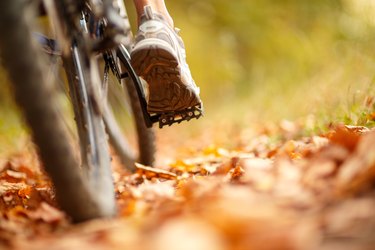
Cycling is an aerobic activity that has many benefits, including aiding in weight loss, helping to lower blood pressure and reducing the risk of heart disease, diabetes and certain types of cancers. Unlike running, which is a weight-bearing activity, cycling is low-impact and gentle on the joints, especially the knees. Cyclists are still prone to injuries however, and many result from the repetitive nature of the sport. One such injury is peroneal tendonitis.
Peroneal Tendons
Video of the Day
There are two peroneal tendons, the peroneus brevis and peroneus longus, that run alongside the large bone on the outside of the ankle. They run side by side, and one attaches to the outer part of the mid-foot. The other attaches near the arch and runs underneath the foot. These tendons, or bands of tissue that connect muscle to bone, work to protect the ankle from a sprain by stabilizing the foot and ankle. A tendonitis occurs when one or both of the tendons become irritated and inflamed.
Video of the Day
Causes
The most common causes of peroneal tendonitis are overuse and muscle sprains. The condition is common in runners, who are prone to twisting their ankle on uneven roads or obstacles, and other sports such as tennis, soccer and basketball. The injury can also affect cyclists. Those with supinated feet, or high arches, are more likely to stress the peroneal tendons and cause inflammation during the thousands of repetitive pedal strokes they take over the course of a bike ride.
Symptoms
This injury can be caused by an acute trauma or can develop over time, which is usually the case with a cyclist. Symptoms often include pain, swelling to the area and often the area around the ankle being warm to the touch. The tendon may feel as though it is burning, and the injury is often accompanied by stiffness and an inability to stretch the area without pain.
Treatment and Prevention
It's important to cease the exercise that causes the pain as soon as possible or the injury could lead to chronic inflammation and damage to the tendon. Treat it with ice, compression, anti-inflammatory pain relievers and decrease your activity while it heals. If pain persists, see your doctor. Assess your bike fit and your cleat position to ensure that it isn't irritating the peroneal tendons. You may want to work with a professional bike fitter to avoid future problems. More pressure is placed on the tendons when you are standing to climb hills. Stay seated in the saddle instead.
Is this an emergency? If you are experiencing serious medical symptoms, please see the National Library of Medicine’s list of signs you need emergency medical attention or call 911.